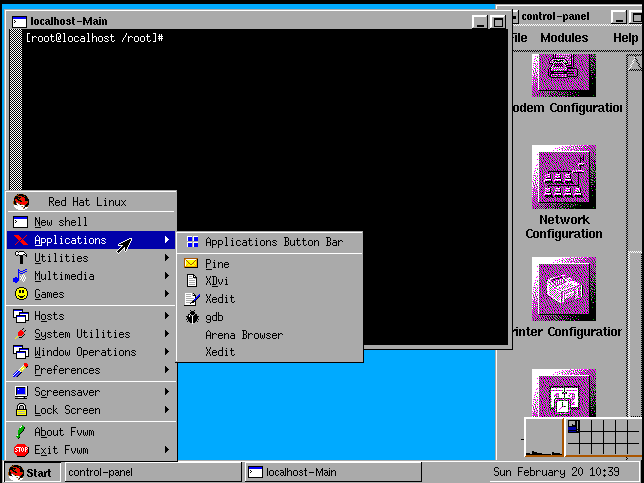Red Hat 3.0.3
Linux Image: Red Hat 3.0.3 (Picasso)
Kernel: 1.2.13 (Stable)
Release Date: May 1, 1996
Feature: First version to release multiple architecture (x86/ELF, Alpha/a.out) at the same time. The Metro-X server, glint graphical management tool for RPM, and graphical printer configuration.
Size: 433 MB
Last Updated: November 3, 2019
After looking at Red Hat Linux 3.0.3, I’m in awe of how quickly the Linux operating system is moving forward. This summer we predicted that Linux, an already popular implementation of old Unix, would infiltrate mainstream corporate America, Europe, Russia, and Asia. If Red Hat Software continue advancing Linux at the present rate, such widespread adoption is guaranteed.

Simply put, Red Hat is easily the best Linux version released to date. It’s a must-try for users new to Linux and a must-have for veterans.
Up, up, and away …
Red Hat’s installation program makes it far easier to install than any other version of Linux I’ve tried, including prior versions of Red Hat. It shields you from enough complexity to keep it simple, yet it provides enough options to satisfy Linux geeks.
Red Hat comes with the Apache Web server, one of the most popular servers on the Internet. The server can be installed, configured, and set to run automatically with no more than a click on a single check box during system installation. Setup of FTP (File Transfer Protocol) services is equally easy.
It’s just as simple to add Web and FTP services after installation. That’s thanks to Red Hat’s now famous — among Linux users, at least — installation and removal utility called Red Hat Package Manager.
The OS can be a network file system (NFS) server to Unix clients, and it can provide native file and print services to any 16-bit or 32-bit Windows client and AppleTalk services to Macintosh clients. Red Hat can also be used as a client to NFS and NetWare.
Red Hat licenses and includes Metro Link Inc.’s accelerated X engine, Metro-X, which supports a long list of display adapters. A number of video cards we had problems in the past with in Windows (including the Elsa Winner 2000 Pro and Matrox Millenium MGA) have enjoyed good support by Metro-X for some time.
The Metro-X driver absolutely blazes on our Matrox Millennium MGA card in the lab. In addition, Metro Link offers OpenGL for Linux separately if you want to build 3-D graphics applications.
A pretty face and more …
This version of Red Hat introduces a new version of FVWM, now called The Next Level. FVWM is a window manager that is configured to look and feel something like Windows, with cascading start menus, a task bar, and a pager that lets you switch among a set of virtual desktops. Switching between desktops on my machine is instantaneous, faster than anything I’ve seen on Windows or OS/2.
The Linux kernel used in this release of Red Hat supports symmetric multiprocessing, a feature that brings Linux into the scalability big league.
It also supports dynamic loading of support modules. That means you can set up the system to load certain features, such as the capability to read OS/2 High Performance File System (HPFS)-formatted drives, only when needed.
Linux can read and write to a long list of file systems, including DOS File Allocation Table (FAT), Virtual FAT (Windows long file names), and HPFS. Free NT File System drivers are also available from a variety of FTP sites.
One of the most important enhancements to this version of Red Hat is support for pluggable authentication modules (PAM). PAM is a tremendously flexible means of letting you choose the levels of security you want to attach to any service your server provides — from simple log-in to remote access of applications and FTP services. Essentially, PAM paves the way to soothe fears about Unix security.
Red Hat implementation of Linux, is the best Linux so far. Big-league features such as broad device support and symmetric multiprocessing make it a powerful yet inexpensive Internet and intranet server that is remarkably easy to install, configure, and maintain.
Pros: Broad device support and symmetric multiprocessing; vastly improved installation process; expanded documentation; better window manager; refined security features; inexpensive price.
Cons: Too difficult to configure the window managers.
Platforms: Intel, Alpha, and Sparc.